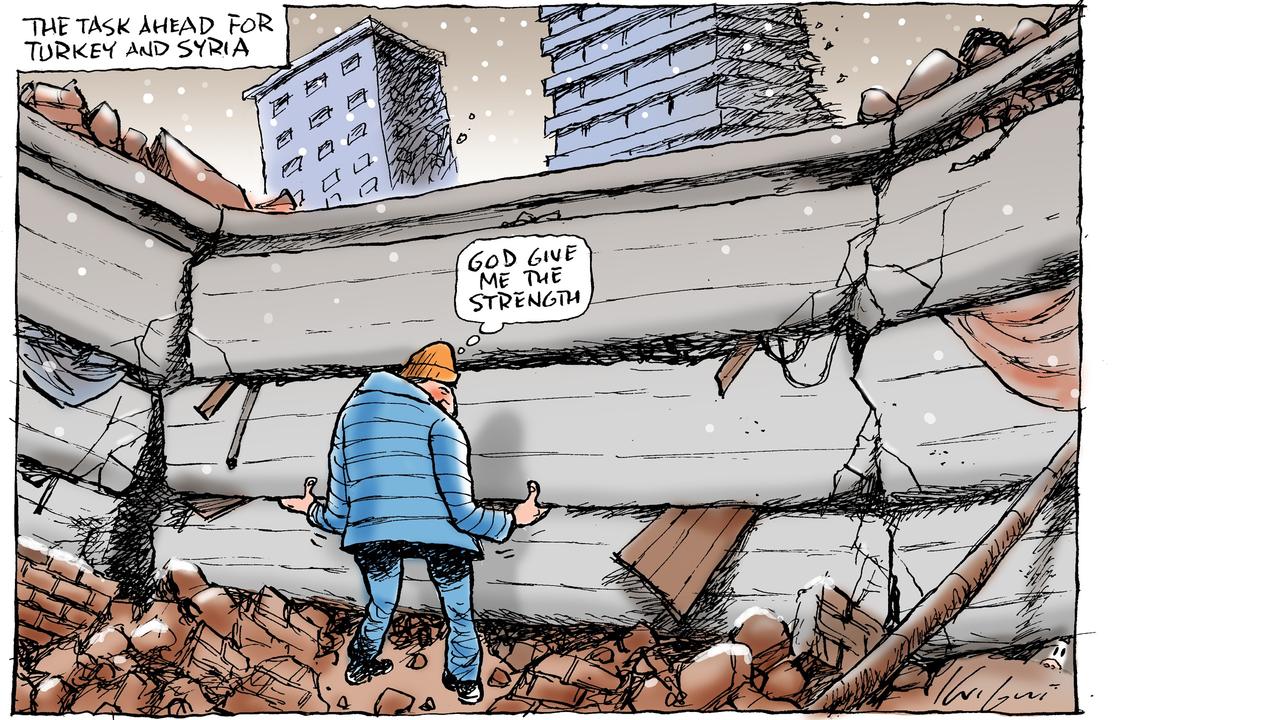Mark Knight cartoon captures scale of earthquake disaster in Turkey and Syria
The recovery task ahead seems almost impossible – but so too does doing nothing – in Mark Knight’s cartoon about the earthquake disaster in Turkey and Syria

READING LEVEL: RED
Not all the topics I draw about in my cartoons are full of mirth*.
On February 6, a massive 7.8 magnitude earthquake hit southeastern Turkey and northwestern Syria.
The quake struck about 4am when everyone was at home in their beds. Such was the force of the earthquake and aftershocks that whole city blocks were destroyed.
In Turkey, locals captured footage on their phones of modern multistorey apartment blocks collapsing to the ground in pancake-like fashion.
Syria, which is yet to recover from its recent civil war, was even harder hit, with the war torn city of Aleppo left in ruins.
But the worst was yet to come, with a death toll estimated at more than 35,000 people. As buildings collapsed like houses of cards, people in most cases had no chance to escape and when the dust settled cries for help could be heard from those trapped under tons of concrete and twisted metal.

Seeing the vision from Turkey and Syria brought home to me the human tragedy of this massive natural disaster. I thought I should make a comment about the earthquake in my daily cartoon for the Herald Sun. Obviously not to make light of it, but to bring attention to the plight* of Turks and Syrians in their hour of need.
Reports from the earthquake zones showed that it was hard for rescue teams to enter the affected areas, with roads and airports destroyed and parts of Syria still locked in continued armed conflict.
The heavy machinery and technical experts needed would take time to get there, as well as aid, food, shelter and medicines for survivors. Being winter in the northern hemisphere, freezing temperatures would take a toll as well.
So people took it upon themselves to try to rescue those trapped, using whatever tools they had, mostly their bare hands. Such is the human desire for survival, we did witness children and adults being freed from under the rubble and brought to the surface to the sound of roaring cheers.

I wanted to show this spirit of survival and what the Turks and Syrians were up against in those first few days after the disaster.
For most, when faced with such calamity*, the first inclination* we have is to help others. No matter what the odds, people will try to lend assistance.
I wanted to illustrate this trait that was clearly on show in this disaster.
I drew a ruined building, the huge collapsed concrete floors lying stacked on top of each other. Then I added a man, trying to lift the concrete on his own with only his hands. It is obviously an impossible task but one he must try, because to do nothing would be equally impossible.
Maybe his efforts will inspire others to join in, to convince governments to act quicker and send assistance. Maybe his struggle is not entirely in vain* if it motivates rescue efforts.
But the cartoon also shows that the task is enormous.
Finally, I added in a speech bubble. The man is asking his god to “give him strength”. The strength needed will not only have to be physical but also mental, to endure* and see a way through such comprehensive devastation.
All strength to the people of Turkey and Syria.
GLOSSARY
- mirth: amusement, happiness, laughter
- plight: dangerous, difficult or unpleasant situation
- calamity: a serious accident or bad event causing damage or suffering
- inclination: a person’s natural tendency to feel or act in a particular way
- in vain: without success or a result
- endure: to last, to remain in existence
EXTRA READING
Aussie spirit shines through flood disaster
What is at the centre of the Earth?
Join Australia’s army of volunteers
QUICK QUIZ
- Which two countries were affected by the earthquake?
- What magnitude was the earthquake?
- Seeing the vision of the aftermath of the earthquake brought what home to Mark?
- What human trait did Mark want to capture in his cartoon?
- Why did Mark draw a man trying to lift concrete on his own with his bare hands?
LISTEN TO THIS STORY
CLASSROOM ACTIVITIES
1. What happens next?
Imagine this cartoon is part of a story that is made up of three cartoons. The three cartoons tell a complete story, and Mark’s cartoon is the start of the story. Think about what the story could be and draw the next two cartoons that tell the story.
Time: allow 30 minutes to complete this activity
Curriculum Links: English, Visual Arts, Visual Communication Design, Critical and Creative Thinking
2. Extension
Being able to draw is only one of the skills needed to be a great cartoonist. Write a list of all of the other skills that you think cartoonists like Mark need to do their job.
Next to each skill, write a sentence that explains why that skill is important or helps them to do a great job.
Time: allow at least 20 minutes to complete this activity
Curriculum Links: English, Personal and Social Capability, Media Arts, Visual Communication Design
VCOP ACTIVITY
Describe it
Look at the cartoon and make a list of five nouns that you see. Then describe those five nouns with five adjectives. Now add a preposition to those five nouns and adjectives.
Finally, choose your favourite bundle and put all the words together to make one descriptive sentence.

